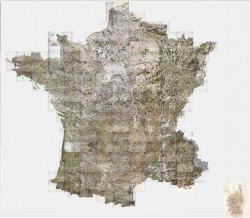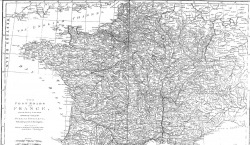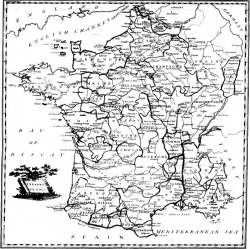**Click on the thumbnails below to access a pdf document**
Cesar-Francois Cassini's 18th Century Map of France

This 18th Century map of France was completed by Cesar-Francois Cassini and published as Carte de Cassini in 1789. On this site, Cassini's map is overlaid onto a Google Map of France, providing the ability to view both contemporary French cities/roads and Cassini's rendering of 18th Century ones.
Additionally, this site provides a fully viewable Cassini map, though it is not compatible with Google Maps.
Additionally, this site provides a fully viewable Cassini map, though it is not compatible with Google Maps.
Emanuel Bowen - A Complete Atlas (1752)

Emanuel Bowen's A Complete Atlas or Distinct View of the Known World was published in London in 1752. Bowen was "geographer to his Majesty," and his Atlas includes detailed maps of the "known world."
A notable feature of this map: it is one of the only to include the label "Gulf of Lyon" in the south of France--a title that Radcliffe absorbs into Adeline's journey from Nice to Montpellier. Map of France on page 14.
A notable feature of this map: it is one of the only to include the label "Gulf of Lyon" in the south of France--a title that Radcliffe absorbs into Adeline's journey from Nice to Montpellier. Map of France on page 14.
John Gibson - Atlas Minimus (1758)

This atlas contained minimized country maps based upon those maps found in Emanuel Bowen's A Complete Atlas. The Atlas is marketed toward "young Gentlemen & Ladies" and boasts in its introduction that "no other Epitome of this kind has been offered to the Publick that is so convenient for the Pocket."
Since this work touted the authoritative name of Emanuel Bowen and was relatively inexpensive, it was presumably widely referenced. It is the least detailed of all the atlases listed here. Map of France on page 18.
Since this work touted the authoritative name of Emanuel Bowen and was relatively inexpensive, it was presumably widely referenced. It is the least detailed of all the atlases listed here. Map of France on page 18.
William Guthrie - The Atlas to Guthrie's System of Geography (1792)

This Atlas is a supplementary piece to Guthrie's A New Geographical, Historical, and Commercial Grammar, which went through numerous editions. The Grammar is an encyclopedic volume that provides the history, terrain, religion, governance, etc., of each place listed in the Atlas.
Map of France on page 12.
Map of France on page 12.
Thomas Kitchin - A General Atlas Describing the Whole Universe (1782)

Kitchin's Atlas, being an "improvement of the maps of D'Anville and Robert," is a collection of country maps "engraved in the best manner on sixty-two copper plates." Kitchen also worked with Bowen (the royal geographer), and so was a recognized name in the industry. Because his map has been printed with copper plates, it is fairly easy to read.
Map of France on page 40.
Map of France on page 40.
Thomas Kitchin - A General Atlas Describing the Whole Universe (1794)

This Atlas is a later version of the one listed above, and provides two maps of France (pp. 39-40). These maps differ from the one above in that they more clearly divide the larger regions of the country while the cities and more detailed information is difficult to make out.
The detailed maps of England, Scotland, and Ireland are worth a look.
The detailed maps of England, Scotland, and Ireland are worth a look.
Gerard Mercator - Atlas or Geographicke Description (1649)

This Atlas, originally compiled by Flemish cartographer Gerard Mercator, was translated and published byHenry Hexham, et al in 1649. This particular edition is unique for two reasons: first, it is a representation of a map that would have been extant during the time in which the novel is set. While Radcliffe was writing in the late 18th century, the action of her story takes place in the mid-17th.
Second, Mercator's Atlas includes both a map of France and very detailed maps of each region--all other maps listed here, save for the Cassini, only include the former.
The file provided here only includes the work's prefatory material and those sections pertaining to French geography.
Second, Mercator's Atlas includes both a map of France and very detailed maps of each region--all other maps listed here, save for the Cassini, only include the former.
The file provided here only includes the work's prefatory material and those sections pertaining to French geography.
T. Stackhouse - An Universal Atlas (1790)

Stackhouse's project in this Atlas is to compare the ancient divisions of cities and countries to contemporary ones. In his work, he provides a list of "Ancient Names" and "Present Names" of countries, the ancient and present subdivisions of those countries, and, to the best he is able, an ancient map and present map of each.
His ancient map of France is on page 36, with his present map on the page following.
His ancient map of France is on page 36, with his present map on the page following.

